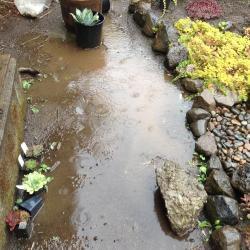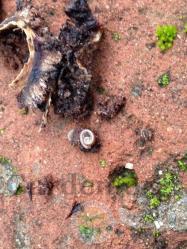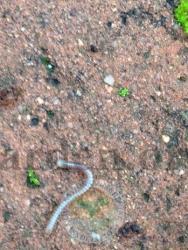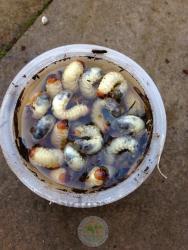Warning... long-winded, boring post ahead.
It's
baaaaack! Cold temperatures and pounding rains have returned, just when I thought I was through with puddles in my yard. A minute ago it turned way dark outside, like the sun had set. The thermometer dropped 10 degrees and then
whammo the sky opened wide up.

But that's not what I'm complaining about right now. I've been learning a bit about our good friend the Leatherjacket. I think they must be everywhere around my yard, including amongst my semps. I think they are the #1 pesky problem that I have growing semps, although it's not really that bad. Nature takes her toll and I just have to deal with that. But it does turn out that almost every time I see a problem that I can't identify above ground, it's a Leatherjack or two underground making trouble.
Here's an example. This guy below is 'Purple Haze' and looks pretty OK. But he has looked just like that for six months now. That's failing to thrive. He felt pretty solid but tugging upwards on him a bit makes it clear that he's not very solidly rooted. So I pulled him up and found exactly what I expected, a compromised root system with a Leatherjacket firmly attached. After replanting, I expect growth to continue.

Here's one of our favorites, 'Bros'. Generally a slow grower but I noticed leaves dying and he was shrinking back. Lifting him up and digging a bit reveals once again a Leatherjacket attack. This was a week ago and he's looking and feeling considerably better already. I can tell his roots are doing better.

Poor little 'Xanthoheuf' was a tiny offset when I got him and he was soon afterwards 40% chewed away. Leatherjackets sometimes come out and eat the semps above ground. When I dug under this semp I found a single Leatherjacket. 'Xanthoheuff' is still small but is rebounding quite well in fact.

I was thinning down a clump of 'Legolas' and found a Leatherjacket but the plant itself was thriving quite well. It seems one Leatherjacket doesn't bother a mature clump too much. Makes sense.
However, my colony of 'Saharasonne' was getting hammered and I thought this couldn't be the work of a single Leatherjacket. I was right... there were 4 under there. Here's the remains of that colony apparently on the mend. Set back but looking much better now.

I wonder how many are down there that aren't causing noticeable damage. I've read that in lawns you can have 25 per square foot and that won't cause a problem. 25-50 they say is a problem. I can't imagine 25 in one square foot... yikes.
I think this might be a good argument for filling your beds with a sterile, commercial mix. Or will they get into that just as readily?
Anyone else bothered with this pest?








